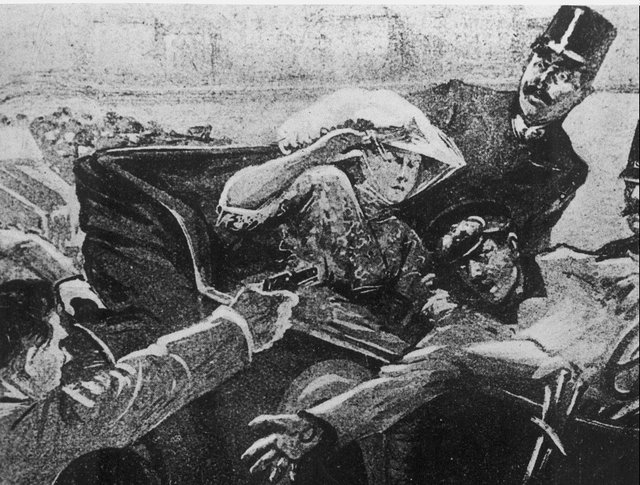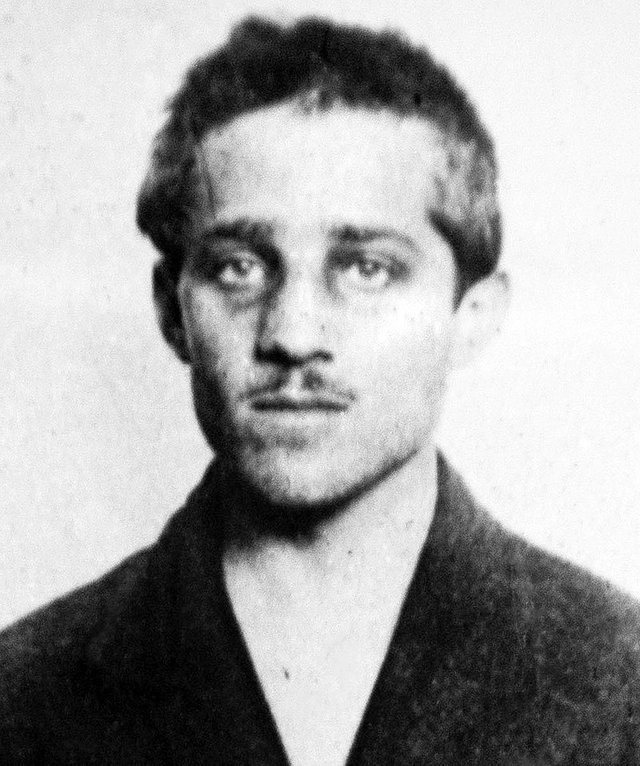The Great War Centenary: Part Two, The Spark
With Europe in a state of high tension in 1914, an assassin's bullet changed the world forever. What was the chain of events that led to the global disaster that was World War One?
This is Part Two of a series of posts leading up to the centenary of the end of The Great War on November 11, 2018. For the reasons leading up to the outbreak of the war, please see The Great War Centenary: Part One, The TinderBox
The Black Hand
The young man could hardly believe it. Stopped, right in front of him was the man his hapless comrades had tried to kill earlier that day and had failed miserably. He didn't have to do anything but whip out his pistol and shoot at virtually point blank range. He must have seen the blood spurt from the neck of the man at the back of the car as he fired off another shot into the body of the woman who was now shielding her mortally wounded husband.
Gavrilo Princip was just nineteen. A slight young man, too small to be accepted into the military, he had just killed the heir to the Austro-Hungarian throne.
On 28 June 1914, Archduke Franz Ferdinand of Austria and his beloved wife Sophie, Duchess of Hohenberg, visited Sarajevo in Bosnia. They were on a visit to the recently annexed Bosnia-Herzegovina, where Franz Ferdinand would attend some military exercises. On the final day of their visit, they had to attend some official events in Sarajevo. On arrival after a short train ride, the Archduke and his wife inspected the troops and then headed to the city hall in an open-topped car in a motorcade. Instead of the six specially trained officers required to accompany them, there was only one, plus three local policemen.
Up ahead a gang of seven young men belonging to a Serbian terrorist group called the Black Hand, lay in wait along the route — which had been published in advance. The upcoming royal visit had spurred the group into plotting an assassination of the Archduke. Back in May, three members of that group — Gavrilo Princip, Trifun Grabež and Nedjelko Čabrinović — all nineteen years old, travelled to the Serbian capital of Belgrade, where they received six hand-held bombs, four semi-automatic pistols and cyanide suicide capsules from members of the Black Hand. After practising with their pistols in a Belgrade park, the three men journeyed to Bosnia-Herzegovina, smuggling their weapons across the border with the help of fellow plotters.
The motorcade passed by the first assassin armed with a bomb. But he didn't act. Another assassin near to him who was armed with a pistol and a bomb also failed to act. Then further along the route, Nedeljko Čabrinović waited armed with a bomb. As Franz Ferdinand's car approached, Čabrinović threw his bomb. But it bounced off the back of the car and exploded under the car behind, wounding a number of people. Čabrinović attempted suicide by swallowing his cyanide capsule and jumping into the river. As fortune would have it, the cyanide was old and ineffective, and the river was only 13 cm deep. He was arrested.
The royal couple got to the city hall, with Franz Ferdinand understandably showing signs of stress. Yet they carried on with the proceedings but decided against continuing with the original plans in favour of going to the hospital to visit those who were wounded by the bomb. Because of this, and because they wanted to avoid the city centre, their planned route was changed.
Gavrilo Princip heard about the earlier failed attempt, so he readied himself in position — on the old route. Not far away, the motorcade took a wrong turn and went down a street onto the old route. Realising their mistake, they tried to reverse out of there. The Archduke's car stalled right in front of Gavrilo Princip. The Croat was immediately arrested after the shooting.
Both victims died while being driven away for treatment.
All the assassins and their helpers were arrested. Gavrilo Princip tried to commit suicide, first by swallowing the out-of-date cyanide, and then by attempting to shoot himself. Princip and his friends escaped the death penalty as they were under 20 at the time the crimes were committed. Five fellow plotters were hanged to death. Princip received the maximum 20-year sentence but died in prison less than four years later.
Reaction
Austria-Hungary immediately blamed the Serbian government for the assassination. Anti-Serbian feelings raged in Sarajevo too, with massive riots and violent attacks on ethnic Serbs.
The murder of the heir to the Austro-Hungarian Empire and his wife produced widespread shock across European royal houses. However, there was little reaction among ordinary people and, even in Vienna, life carried on as if nothing had happened.
Austria-Hungary sent a letter to the Serbian government reminding them of its commitment to respect the Great Powers' decision regarding Bosnia-Herzegovina and to maintain good neighbourly relations with Austria-Hungary. The letter also contained demands which included the arrest of all those who were involved in the assassination. This letter became known as the July Ultimatum and in it, Serbia was given 48 hours to comply with all the demands.
Serbia's response was to first get an assurance of support from Russia, then mobilise its forces. It replied to the letter accepting some points and vaguely rejecting others. Austria-Hungary responded by breaking off diplomatic relations. The next day, Serbian troops were being transported across the Danube into Austria-Hungary.
In turn, Austria-Hungary received assurances of German support and on 28 July 1914, Austria-Hungary declared war on Serbia.
Because of the alliances that had been set up among the nations, Russia mobilised its forces. That set off full Austria-Hungarian and German mobilisation.
The sides had been chosen and the fragile peace between Europe’s great powers had started collapsing.
This series on World War One will be continued in Part Three, tomorrow
Previous post in this series:
The Great War Centenary: Introduction.
The Great War Centenary: Part One, The Tinderbox
References:
The Guns of August, Barbara Tuchman
https://www.history.com/this-day-in-history/archduke-ferdinand-assassinated
https://www.history.com/news/the-assassination-of-archduke-franz-ferdinand-100-years-ago
https://en.wikipedia.org/wiki/Assassination_of_Archduke_Franz_Ferdinand


For years I've been wondering how the assassination of Archduke Ferdinand, while no doubt tragic for the royals of Austria, could possibly have triggered a world war. Thanks to these last two posts I'm now finally starting to get it. It's almost more complicated than the 6-country axis of Trump.
Haha - another nationalist alliance in the making
Eek - no joke.
Interesting content from WW1 different pieces of the puzzle that set about during this time.
Visiting from #teamsouthafrica
Now in alliance 😁, go #teamsouthafrica